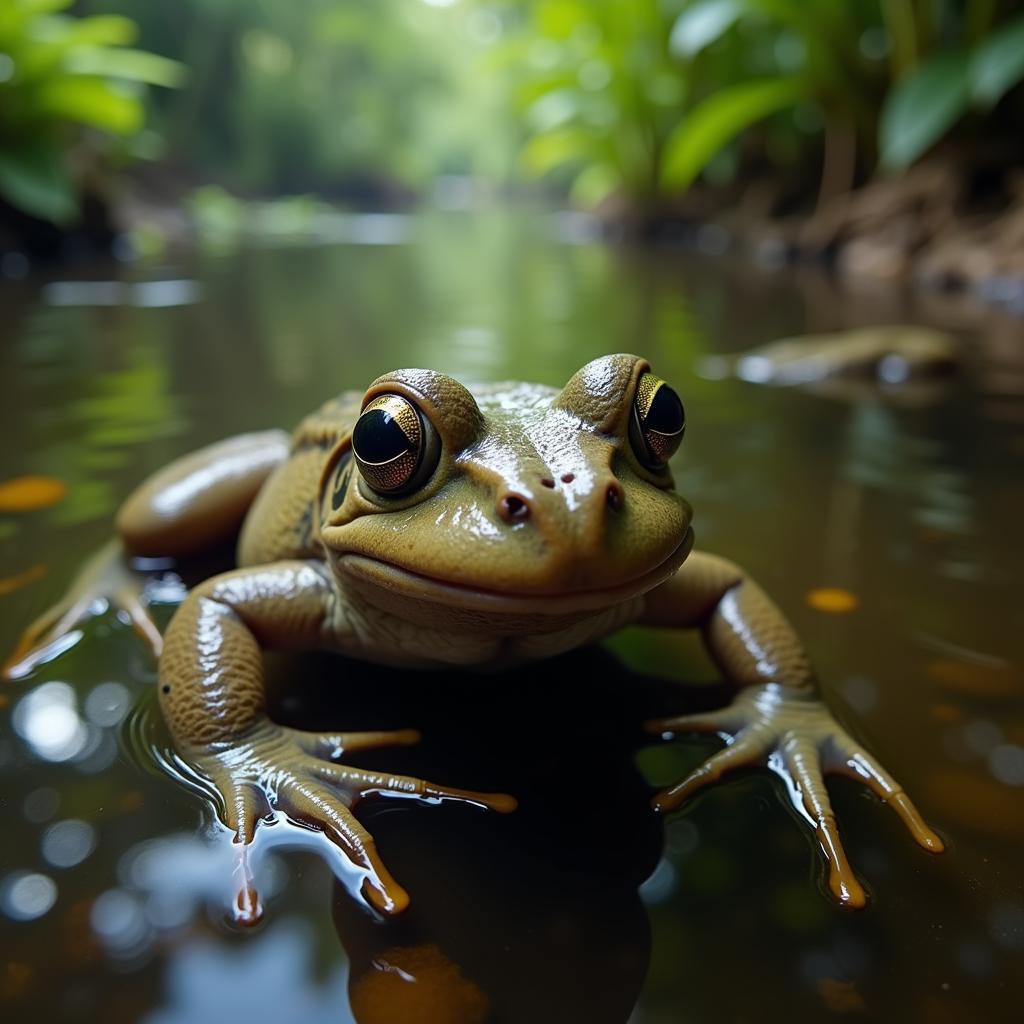African Clawed Frog Facts: A Deep Dive into Xenopus laevis
African clawed frogs, scientifically known as Xenopus laevis, are fascinating creatures with a rich history and unique characteristics. In this article, we’ll explore everything you need to know about these intriguing amphibians, from their physical traits and habitat to their surprising role in scientific research.
 African clawed frog swimming in its natural habitat, showcasing its unique features and adaptations for aquatic life.
African clawed frog swimming in its natural habitat, showcasing its unique features and adaptations for aquatic life.
Physical Characteristics of African Clawed Frogs
African clawed frogs are fully aquatic, lacking a tongue and visible ears. They are easily recognized by their flattened bodies, small eyes positioned on top of their head, and of course, their namesake claws on their hind feet. These claws, three on each hind foot, are used for tearing food and digging in the muddy substrate of their habitat. They also have powerful back legs adapted for swimming, propelling them through the water with ease. These frogs are typically olive-green or gray in color, providing excellent camouflage in their natural environment. Some individuals may also display spots or stripes. Their smooth skin allows them to glide effortlessly through the water.
Habitat and Distribution: Where Do African Clawed Frogs Live?
African clawed frogs are native to sub-Saharan Africa, thriving in warm, still or slow-moving bodies of water such as ponds, swamps, and ditches. They are highly adaptable creatures, capable of surviving in a range of aquatic environments, including those with low oxygen levels. This adaptability has unfortunately contributed to their invasive status in some parts of the world, where they have been introduced and outcompeted native species.
Diet and Feeding Habits: What Do African Clawed Frogs Eat?
These frogs are voracious carnivores, employing a sit-and-wait strategy to ambush their prey. Their diet consists primarily of aquatic invertebrates like insects, worms, and crustaceans. They also consume small fish, tadpoles, and even other frogs. Their sensitive fingers help them detect vibrations in the water, allowing them to locate potential meals even in murky conditions.
 An African clawed frog capturing and consuming an insect in its aquatic environment, demonstrating its carnivorous feeding habits.
An African clawed frog capturing and consuming an insect in its aquatic environment, demonstrating its carnivorous feeding habits.
African Clawed Frogs in Scientific Research
Perhaps surprisingly, African clawed frogs have played a significant role in scientific research, particularly in the fields of developmental biology and endocrinology. They were once widely used in pregnancy tests, and continue to be valued for their ability to regenerate limbs and adapt to various environmental conditions. Their large eggs and rapid development make them ideal subjects for studying embryonic development.
Dr. Anya Sharma, a renowned herpetologist specializing in African amphibians, notes, “The African clawed frog has been instrumental in advancing our understanding of vertebrate development. Its unique characteristics make it a valuable model organism for scientific research.”
African Clawed Frog: An Overview
African clawed frogs are intriguing amphibians found in sub-Saharan Africa, known for their distinctive physical features, including clawed hind feet and smooth skin. These aquatic creatures are adaptable to various environments, thriving in warm, still or slow-moving waters. Their carnivorous diet consists primarily of aquatic invertebrates, small fish, and even other frogs. Notably, these frogs have been invaluable in scientific research, contributing significantly to our knowledge of developmental biology and endocrinology.
FAQs about African Clawed Frogs
-
Are African clawed frogs poisonous? No, African clawed frogs are not poisonous to humans. However, their skin secretions can sometimes cause mild irritation.
-
How long do African clawed frogs live? In captivity, African clawed frogs can live up to 15-20 years, while in the wild, their lifespan is typically shorter.
-
Can African clawed frogs be kept as pets? Yes, African clawed frogs can be kept as pets, but they require specific aquatic environments and care.
-
Are African clawed frogs invasive? Yes, in some regions outside their native habitat, African clawed frogs have become invasive, disrupting local ecosystems.
-
What are the predators of African clawed frogs? Predators include birds, snakes, and larger fish.
Professor Adebayo Olufemi, a leading expert in African wildlife conservation, observes, “The introduction of African clawed frogs to non-native habitats has unfortunately had detrimental consequences for native species.”
african congo rainforest animals
Conclusion: The Remarkable African Clawed Frog
The African clawed frog, with its unique adaptations and surprising scientific significance, is a truly remarkable creature. Understanding these fascinating animals is crucial for appreciating the rich biodiversity of the African continent and for promoting responsible practices in scientific research and pet ownership. Their continued study promises to unlock further insights into vertebrate development and adaptation.
For assistance, please contact us at Phone: +255768904061, Email: kaka.mag@gmail.com or visit us at Mbarali DC Mawindi, Kangaga, Tanzania. We have a 24/7 customer service team.

